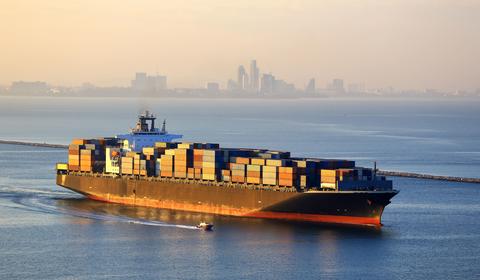
EU ETS extends to maritime industry
How stakeholders can prepare for compliance
The European Union Emissions Trading System (EU ETS) is set to extend its reach to the maritime industry starting in January 2024. Stakeholders are faced with a steep learning curve as they must rapidly adapt to the new regulations while competing against established companies that are well-versed in the EU ETS trading market.
Following the 2005 entry into force of the Kyoto Protocol, the EU ETS was launched to reduce greenhouse gas (GHG) emissions via a market-based mechanism. A strong lever that has gained even more importance in the context of the European Green Deal, the EU ETS is built on a “cap and trade” principle.
The “cap” component consists of a limited quantity of Emission Allowances (EUAs). These EUAs – the number of which is reduced over time – are issued by the Commission. For shipping actors, there will be two main options to acquire the necessary EUAs: either from the Primary market via auctioning, or from the Secondary market via bilateral agreement.
Since each operator must surrender enough EUAs to fully cover its GHG emissions with EU ETS scope, it is incentivized to actively reduce these emissions. Its objective should be either to keep the extra allowances for future needs, or to sell them to other market players whose emissions exceed their amount of available EUAs.
The trading aspect of the program comes into play as the available EUA stock goes down, while the price rises – and the incentive to reduce emissions also grows.
Originally focused only on heavy industries (e.g., steel, cement and power plants), the EU ETS widened its scope by integrating aviation in 2012. This decision paved the way for a more generalized carbon constraint within the EU economy. Within that perspective, the program will be extended to the maritime industry starting on January 1, 2024. Cargo and passenger vessels of 5,000 gross tonnage and above will be impacted, including those registered outside the European Economic Area (EEA) that enter EEA ports.
This move represents an evolution from the EU Monitoring, Reporting and Verification (EU MRV) regulation, which currently requires shipowners to monitor and report on their vessels’ CO2 emissions on a tank-to-wake basis. Under the EU ETS, shipowners must purchase EUAs to cover their emissions. On top of that, CH4 and N2O emissions will have to be monitored for the first two years of entry into force (i.e., inclusion in the EU MRV) and included in the EU ETS starting in 2026.
There are still clarifications to be made concerning the EU ETS, which will occur later this year based on upcoming Implementing & Delegated Acts. Accurate monitoring of upcoming Regulatory developments is needed to limit its impact and to define an optimum GHG strategy at fleet level. For example, clarification is still to come regarding low-carbon fuels consideration, carbon capture and storage, and the provision of transshipment ports.
As the number of available EUAs decreases each year, stakeholders must, in order to remain competitive, seek to purchase them at an optimal price. Meanwhile, they need to keep a close eye on their cash management and risk exposure. In that regard, aside from the spot auction process, various possibilities can be considered on the “secondary” market (e.g., forward buying and financial hedges.)
Sustainability Strategy Leader
BV Solutions M&O
Maritime companies will face challenges around the EU ETS. At BVS, we’re committed to playing our part in this effort and supporting the industry through the transition. Our aim is to help maritime stakeholders navigate the complexities of the EU ETS while defining best-suited strategies to ensure Regulatory compliance while optimizing the economic and technical choices.
Navigating fuel hedging strategies in the face of EU ETS
Shipowners will therefore need to rethink their fuel hedging strategies in light of the forthcoming EU ETS requirements. Fuel hedging, the approach to buying fuel ahead of time when prices are perceived as advantageous, must now factor in the cost of carbon allowances.
To address this challenge, BVS has partnered with ENGIE, a global reference in low-carbon energy and services with decades of experience in carbon trading. ENGIE’s expertise in purchasing EUAs at the best price and at the right moment is crucial for shipowners facing new metrics that impact fuel hedging strategies. ENGIE can support shipowners in navigating the complex carbon markets, providing them with access to carbon credits and managing the cash required to purchase them.
However, cost of the EU ETS is expected to remain quite high, and this is where BVS comes in. We can help shipowners reduce their fuel consumption at the fleet level. We do this by helping determine which ships need to reduce their speed, which can be retrofitted, and which should adapt their operating profiles. And in a worst-case scenario, we can help plan end of life for their oldest and less efficient assets. By reducing GHG emissions, shipowners can decrease their EUA requirements and ultimately lower their costs.
From MRV to ETS: a new era of emissions management for the maritime sector
As the maritime industry prepares for inclusion in the EU ETS, asset owners need to be proactive in reducing their emissions. Compliance with the new regulation could cost shipowners between €3 million and €4 million per year for a Neopanamax container ship operating between Asia and Europe, for example. It is therefore crucial for stakeholders to understand how to manage their GHG emissions effectively.
We recommend the following four-step process to develop a fleet GHG strategy:
1.Collect data: Ensure that all relevant data and possible indicators are available to provide a comprehensive understanding of the fleet’s current performance and emissions.
2.Audit: Perform a thorough review of the fleet’s actual performance based on recognized indicators, such as the Energy Efficiency Existing Ship Index (EEXI), Carbon Intensity Indicator (CII), fuel GHG intensity, or any other metrics, to establish a baseline. We recommend calculating baselines for each vessel and forecasting based on different relevant scenarios and associated sensitivity analysis.
3.Plan: Develop a strategy that anticipates the different mitigation solutions and developments needed to improve vessel performance. This includes assessing the impact and possible benefits of several enablers to reduce GHG emissions while also considering ship age, type and fleet as a whole. Define decarbonization targets and develop simplified consumption models to benchmark different scenarios.
4.Act and measure: Turn the strategic plan into a technical roadmap and provide supporting engineering to implement the validated solutions. Prepare a measurement plan to follow up on their effectiveness.
The challenge of the EU Emissions Trading System for the shipping industry: How to comply at best?
